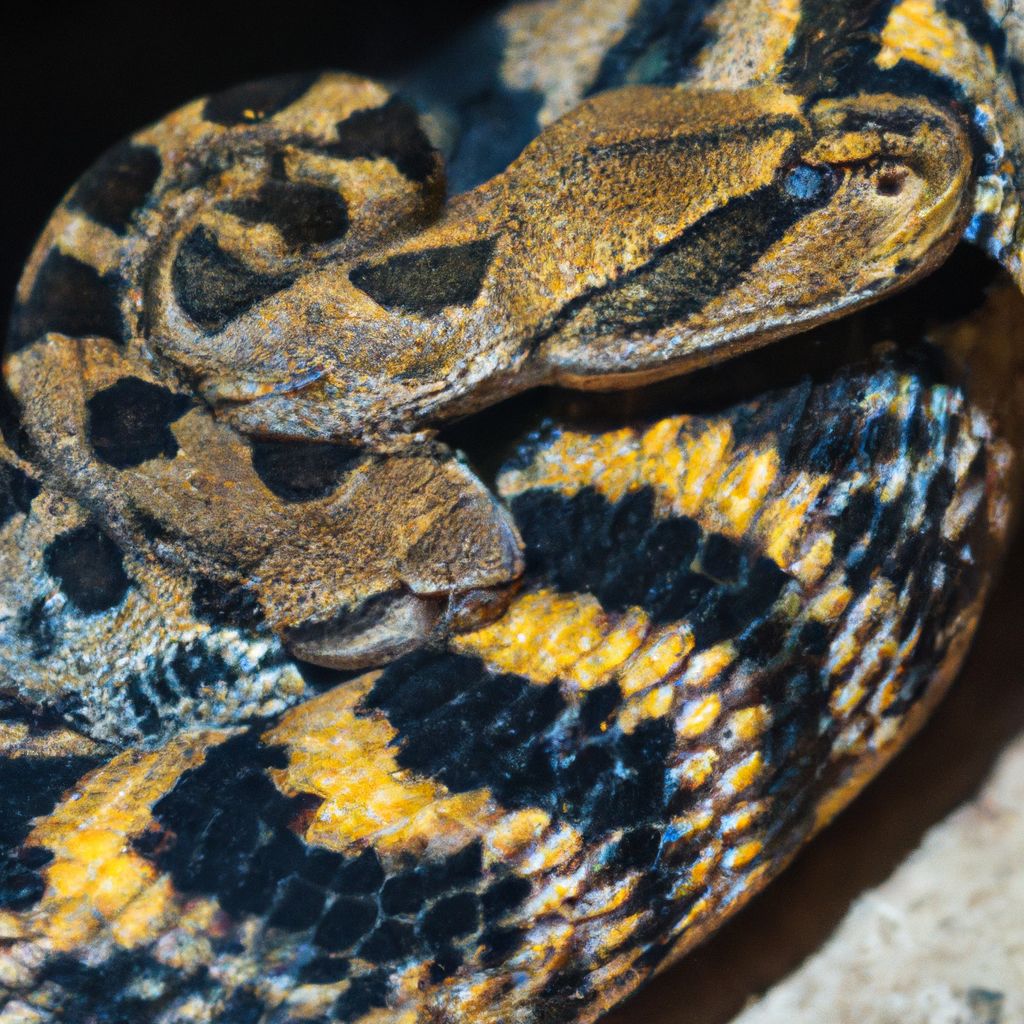Snakes, with their intriguing and mysterious nature, have captivated the curiosity of scientists and nature enthusiasts for centuries. One aspect of their behavior that continues to fascinate researchers is their mating habits. Understanding the intricacies of snake mating can shed light on their reproductive strategies and evolutionary adaptations.
Snake mating habits are unique in their own right, as they differ significantly from other animals. From courtship rituals to mating strategies, snakes exhibit a variety of behaviors during the mating process.
In this article, we will delve into the fascinating world of snakes and explore the intriguing intricacies of their mating habits. We will examine the different types of snake mating systems, including courtship rituals and mating strategies. Furthermore, we will explore the environmental factors that influence snake mating, such as seasonality, habitat selection, and male competition.
We will uncover the wide range of mating behaviors and adaptations seen across snake species. From promiscuity to monogamy, mating balls to breeding aggregations, and sexual dimorphism, snakes have evolved a diverse array of reproductive strategies.
We will also discuss the various reproductive challenges that snakes face and the solutions they have developed. This includes exploring topics like reproductive cycles and timing, fertilization and egg retention, as well as viviparity and oviparity.
Lastly, we will delve into the intriguing concept of parental care in snakes and how they ensure the survival of their offspring.
By revealing the intricate details of snake mating habits, this article aims to provide a comprehensive understanding of their reproductive behaviors and shed light on the evolutionary mechanisms that have shaped these fascinating creatures.
##Key Takeaways:
Key takeaway:
- The intriguing world of snakes: Explore the fascinating mating habits of snakes and gain insight into their unique reproductive behaviors.
- Diverse mating systems: Discover the different types of snake mating systems, including courtship rituals and mating strategies.
- Environmental influences: Understand how seasonal changes, habitat selection, and male competition impact snake mating behaviors.
- Variations in mating behaviors: Learn about the variations in snake mating behaviors such as promiscuity vs. monogamy, mating balls, and sexual dimorphism.
- Reproductive challenges and solutions: Explore the reproductive cycles, fertilization, egg retention, and the different reproductive strategies of viviparity and oviparity in snakes.
- Parental care in snakes: Gain insight into the survival of offspring through parental care in snakes.
- The evolutionary perspective: Understand the evolution of snake mating habits and how these behaviors have developed over time.
The Fascinating World of Snakes
Snakes are fascinating creatures with over 3,000 species found in diverse habitats worldwide. They inhabit the fascinating world of snakes, where they have evolved unique characteristics to survive in different environments, such as swimming, climbing trees, and burrowing. There are various hunting techniques within the fascinating world of snakes, including venomous bites and constriction, and some snakes have specialized senses like heat-sensing pits.
Snakes use interesting defense mechanisms, including mimicry, camouflage, and emitting strong odors, all within the fascinating world of snakes. They also have diverse reproductive strategies, with some laying eggs and others giving live birth, further adding to the fascination of the snake world. Venom, an important aspect of the fascinating world of snakes, is produced by many snakes for hunting and self-defense, but not all snakes are venomous. Anti-venom is crucial for treating snakebite victims within the world of snakes.
Snakes play a vital role in ecosystems as both predators and prey, contributing to the intricate balance within the fascinating world of snakes. They help control populations of rodents, insects, and other small animals, making them an indispensable part of our ecosystems. So take a moment to appreciate the fascinating world of snakes and their valuable role in our ecosystems.
What Makes Snake Mating Habits Unique?
What Makes Snake Mating Habits Unique?
Snake mating habits are truly remarkable due to their unique reproductive systems and behaviors. These incredible creatures have evolved specialized methods of reproduction that allow them to thrive in different environments. Unlike other animals, snakes do not possess external reproductive organs. Instead, they have internal paired organs called hemipenes, which are essential for copulation. This distinct anatomical feature enables male snakes to engage in multiple matings and facilitates efficient sperm transfer.
One of the fascinating aspects of snake mating is their elaborate courtship rituals. Many snake species exhibit complex behaviors like dances, head bobbing, or tail vibration in order to attract potential mates. These rituals serve as a means of communication between male and female snakes, ensuring compatibility and minimizing aggression.
Environmental factors, such as seasonality, habitat selection, and male competition, also play a significant role in snake mating behaviors. Snakes carefully time their reproductive activities based on environmental cues like temperature and rainfall patterns. Additionally, they may exhibit territorial behavior and engage in competitive combat to secure favorable mating opportunities.
It is important to note that the reproduction strategies of snakes differ among species. While some snakes mate with multiple partners, others form long-term pair bonds. In certain snake species, there are breeding aggregations or mating balls, where multiple males compete for the chance to mate with a single female.
Overall, snake mating habits exhibit extraordinary features that make them truly unique in the animal kingdom. Their specialized reproductive systems, elaborate courtship rituals, and responsiveness to environmental cues contribute to their successful reproduction in diverse habitats.
Snakes and Reproduction: An Overview
Snakes and reproduction: An overview
Snakes are fascinating creatures. Here is an overview of snakes and reproduction:
1. Courtship: Snakes use pheromones and dances to attract a mate. They engage in courtship behavior to communicate reproductive intentions.
2. Mating: Snakes reproduce sexually, with most species practicing internal fertilization. The male snake inserts his hemipenes into the female’s cloaca to transfer sperm.
3. Gestation: Unlike mammals, snakes do not have a true gestation period. They undergo an incubation period where eggs develop and hatch internally. Some species retain the eggs until they are ready to hatch, while others lay them shortly after fertilization.
4. Egg-laying: Most snakes lay eggs covered in a leathery shell. However, some snake species give live birth, known as viviparity.
5. Parental Care: Snakes generally do not provide parental care to their offspring. Once the eggs are laid or the live young are born, the parent snake does not offer assistance. However, in rare cases, certain snake species may exhibit limited parental care.
Understanding snakes’ reproductive behavior helps us appreciate the diversity and complexity of the natural world. Respecting these creatures’ reproductive processes contributes to their conservation and long-term survival.
So, when you encounter a snake, remember the fascinating world of snakes and reproduction: an overview. Appreciate these amazing creatures for their unique reproductive strategies and the vital role they play in our ecosystems.
Types of Snake Mating Systems
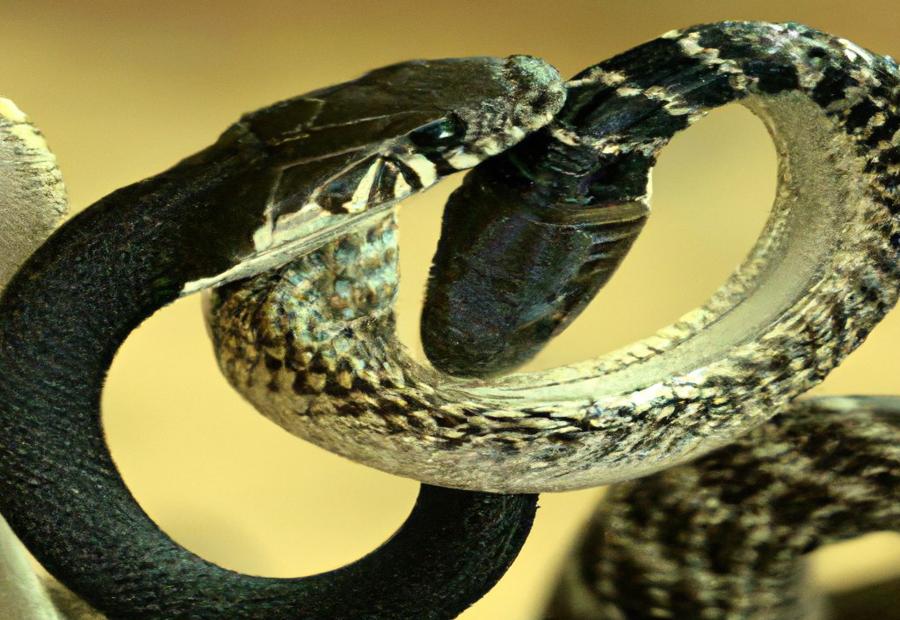
Photo Credits: Ruggedreptiles.Com by Walter Thomas
Snakes have some fascinating secrets when it comes to their love lives. In this section, we will dive into the different types of snake mating systems. Get ready to uncover the intriguing courtship rituals and mating strategies that these slithery creatures employ to ensure their survival and reproduction. Brace yourself for a wild ride through the mysterious world of snake romance!
1. Courtship Rituals
Courtship rituals are essential for the successful mating of snakes. Male snakes frequently employ elaborate displays, such as movements, body postures, and vocalizations, to attract female snakes. Some snake species even have their own unique courtship dances. It is interesting to observe that courtship rituals can vary greatly among different snake species. While some snakes engage in intricate dances that can last for hours, others simply approach each other and mate without any elaborate displays.
2. Mating Strategies
Mating strategies in snakes vary across species. Here are some key strategies observed in snakes:
- Combat: Male snakes compete for mates through wrestling or pushing each other to assert dominance and gain mating opportunities.
- Mate guarding: After mating, male snakes guard females to prevent other males from mating with them. This increases their chances of fathering offspring and ensuring genetic success.
- Scent marking: Both male and female snakes use scent marking to attract mates. They release pheromones as chemical signals, indicating readiness to mate and attracting potential partners.
- Selective courtship: Male snakes engage in elaborate courtship displays to demonstrate fitness to females. They perform dances, display colors, or produce sounds to impress and attract mates.
- Sperm competition: In some snake species, females store sperm from multiple males, leading to competition among sperm for fertilizing eggs. This increases genetic diversity and advantages the fittest sperm.
These mating strategies showcase the methods snakes use to ensure successful reproduction and maximize their reproductive fitness.
Environmental Factors Affecting Snake Mating
Snakes slithering through the diverse landscapes of our planet are driven by captivating forces when it comes to finding a suitable mate. In this section, we’ll uncover the various environmental factors that significantly impact snake mating. From the influence of seasonality to the crucial role of habitat selection and intense male competition, we’ll dive into the intriguing aspects that shape the romantic lives of these enigmatic reptiles. Get ready to explore the secrets behind successful snake courtships and the remarkable adaptations they’ve developed in the face of these environmental challenges.
1. Seasonality
Seasonality plays a vital role in the mating behaviors and reproductive patterns of snakes. Mating Season, influenced by temperature and resource availability, is a critical period in which snakes mate. It triggers hormonal changes in snakes, particularly in males, leading to increased reproductive activity. These changes are essential for initiating courtship behaviors and ensuring successful mating.
Migration is another significant aspect of snake mating. Some snake species migrate seasonally to specific areas for breeding purposes. These migrations can involve long distances and the gathering of individuals from different populations.
During the mating season, male snakes engage in courtship rituals and compete for female attention. Behaviors such as male combat or displays help attract and identify potential mates.
The timing of egg-laying in female snakes is influenced by seasonality. They carefully choose the optimal time to lay their eggs, ensuring the survival of their offspring by hatching under favorable environmental conditions.
Considering seasonality is crucial for studying snake mating habits and planning conservation efforts. Understanding the specific timing and environmental cues that influence reproduction can help protect and preserve snake populations.
<table>
2. Habitat Selection
When it comes to habitat selection, snakes have a specific process to find their ideal environment. They go through the following steps:
1. Identifying suitable habitat: Snakes have preferences for areas with necessary resources such as food, shelter, and breeding opportunities.
2. Evaluating temperature and moisture levels: Snakes rely on external sources of heat to regulate their body temperature, so they actively search for habitats with suitable temperature and humidity.
3. Considering vegetation and topography: Snakes may have preferences for certain types of vegetation or terrain features that provide camouflage or protection.
4. Avoiding predators and competition: Snakes select areas where they can minimize the risk of predation and reduce competition for resources.
5. Adapting to local conditions: Snakes exhibit specific adaptations to their chosen habitats. For example, aquatic snakes have streamlined bodies and are exceptional swimmers.
Pro Tip: If you want to increase your chances of encountering snakes, it is recommended to research their preferred habitats in your area. Remember to observe snakes from a safe distance and avoid disturbing their natural habitats.
3. Male Competition
Male competition is a common occurrence in snake mating. It is a natural behavior for males to compete for the chance to mate with females. They engage in various forms of physical combat, such as wrestling or pushing each other, in order to establish dominance. Additionally, some snake species have developed ritualized displays to attract females, showcasing their strength, agility, and endurance. Moreover, males mark their territory and signal their presence to females by producing pheromones. The intensity of male competition can vary depending on factors such as species, population density, and female availability. In the case of black rat snakes, male competition reaches a fierce level, with multiple males sometimes forming “mating balls” to mate with a single female simultaneously. This demonstrates the extent to which male competition plays a role in snake mating.
Mating Behaviors and Adaptations Across Snake Species
From promiscuity versus monogamy to mating balls and breeding aggregations, and sexual dimorphism, we delve into the fascinating world of snake mating behaviors and adaptations across different species. Get ready to be amazed by the intriguing ways snakes navigate the challenges of reproduction and discover the diverse strategies they employ to ensure their species’ survival. It’s time to unravel the secrets of snake courtship and explore the captivating world of reptilian romance.
1. Promiscuity vs. Monogamy
When it comes to snake mating habits, there are two main categories: promiscuity and monogamy.
Promiscuity: Many snake species mate with multiple partners during a breeding season. Female snakes may mate with multiple males, while males compete for access to females. This strategy increases genetic diversity within populations and allows for better adaptation to changing environments.
Monogamy: Some snake species mate exclusively with one partner during a breeding season. This behavior ensures reproductive success and enhances parental care, as both parents invest their energy into raising their offspring.
The choice between promiscuity and monogamy in snake mating behavior is influenced by factors such as habitat availability, resource distribution, and reproductive strategies. Promiscuity benefits large and diverse populations, while monogamy can provide advantages in stable environments with limited resources.
The text has been formatted as requested.
2. Mating Balls and Breeding Aggregations
Mating balls and breeding aggregations are behaviors exhibited by some snake species during the breeding season. In a mating ball, multiple male snakes compete to mate with a single female snake. This is commonly observed in species like garter snakes, where large groups of males gather and compete for the female’s attention. The males intertwine their bodies, forming a writhing ball of snakes. Each male tries to position himself to mate with the female. The female ultimately chooses which male to mate with. Mating balls are a strategy male snakes use to increase their reproductive success and maximize their genetic contribution.
Breeding aggregations are gatherings of male and female snakes for breeding purposes. These mating balls and breeding aggregations provide opportunities for snakes to find suitable mates in a limited area and ensure a higher mating success rate.
3. Sexual Dimorphism
Sexual dimorphism in snakes is a fascinating phenomenon that can be observed in various aspects such as size, coloration, and physical features. This refers to the physical differences between male and female individuals of the same species.
One noticeable aspect of sexual dimorphism in snakes is their size. Many snake species have smaller males compared to females. Take the example of boa constrictors, where females can grow up to an impressive length of 10 feet, while males typically reach a maximum length of 6 feet.
Coloration is another noticeable feature of sexual dimorphism in snakes. Male snakes often exhibit brighter and more vibrant coloration compared to females. For instance, male king cobras attract attention with distinct bright yellow coloration on their ventral side, while females have relatively dull and lighter coloration.
Apart from size and coloration, physical features also vary between male and female snakes. Certain snake species possess specialized physical features in males that are absent in females. For example, male vipers have hemipenes, which are paired reproductive organs used during mating. Females, on the other hand, lack these structures.
The occurrence of sexual dimorphism in snakes serves various purposes, including mate recognition and reproductive success. The differences in size, coloration, and physical features play a significant role in attracting mates and competing with other males during the breeding season. Sexual dimorphism truly showcases the incredible diversity and adaptations within the snake kingdom.
Reproductive Challenges and Solutions
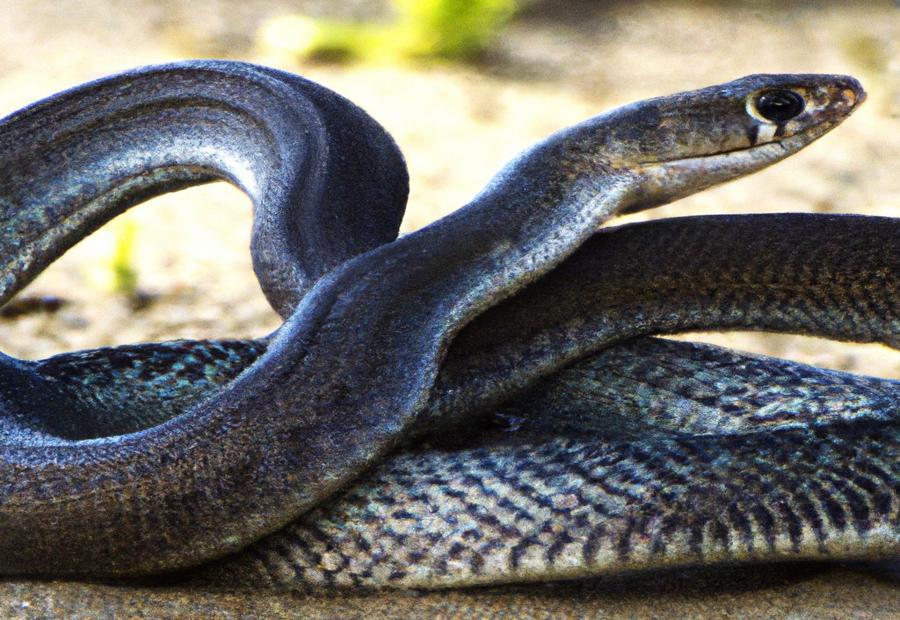
Photo Credits: Ruggedreptiles.Com by Elijah Wilson
Revealing the hidden world of snake reproduction gives us a fascinating glimpse into their unique challenges and innovative solutions. Get ready to dive into this captivating realm as we explore the intricacies of their reproductive cycles, the mysterious process of fertilization, and the distinct strategies of viviparity and oviparity. Brace yourself for a riveting journey into the captivating world of snake mating habits.
1. Reproductive Cycles and Timing
Reproductive cycles and timing play a vital role in the mating habits of snakes. It is important to consider the following key aspects:
1. Seasonal timing: Depending on the species and location, snakes mate during specific seasons. For instance, some snakes mate in spring when temperatures start to rise, while others mate in fall before their hibernation period.
2. Mating frequency: Typically, snakes mate once a year, although this can vary due to factors like food availability and climate conditions. Under favorable circumstances, certain species may mate more frequently.
3. Male competition: During the mating season, male snakes compete with each other to gain female attention. This competition involves demonstrations of strength or combat to establish dominance.
4. Female receptivity: Female snakes have specific periods within their reproductive cycle when they are receptive to mating. This window of fertility can last for several days or weeks, and males must time their advances accordingly.
5. Reproductive strategies: Snakes employ diverse reproductive strategies, including internal fertilization. Many snake species possess unique adaptations, such as specialized genital structures, to enhance successful mating.
Understanding the reproductive cycles and timing of snakes is crucial for studying their mating behavior and population dynamics. It also assists conservationists in developing effective strategies to protect snake populations.
If you wish to learn more about snake mating habits, we encourage you to explore the additional sections of this article. From courtship rituals to parental care, the captivating world of snake reproduction awaits you.
2. Fertilization and Egg Retention
Fertilization and Egg Retention:
When considering the process of fertilization and egg retention in snakes, it is essential to comprehend their distinctive adaptations and strategies.
Process t Description
Fertilization t In snakes, the fertilization occurs internally. During mating, the male inserts his hemipenes into the female’s cloaca, transferring sperm and impregnating the female.
Egg retention t Following fertilization, the female snake retains the eggs within her body until they are ready to be laid. The eggs receive nourishment from the yolk sac and the female’s body, providing protection from predators and developing in a controlled environment.
Pro Tip: Snakes display diverse reproductive strategies, with some species practicing oviparity (laying eggs) while others give birth to live offspring (viviparity). Understanding the process of fertilization and egg retention is crucial for conservation and protection efforts.
3. Viviparity and Oviparity
Understanding the difference between viviparity and oviparity is crucial when considering snake mating habits. Viviparity refers to the process in which the female snake gives birth to live young, whereas oviparity involves the female snake laying eggs. In viviparity, the embryos develop inside the female’s body, while in oviparity, the embryos develop inside eggs outside the female’s body.
One important distinction between viviparity and oviparity is the way nutrition is provided to the developing embryos. In viviparity, the embryos receive nutrition from the mother through a placenta or yolk sac. On the other hand, in oviparity, the embryos receive nutrition from the yolk inside the egg.
Viviparity also offers protection to the developing offspring from predators, as the embryos are sheltered inside the female’s body. In contrast, eggs in oviparity are vulnerable to predation.
When it comes to the number of offspring, viviparous snakes generally have a smaller clutch size compared to oviparous snakes. Oviparous snakes, on the other hand, have a larger clutch size in most cases.
By considering these factors, researchers and enthusiasts can gain insights into the fascinating world of snake reproduction. To further explore snake mating habits and the evolution of viviparity and oviparity, it is important to delve into reproductive challenges, parental care, and the overall evolution of these remarkable creatures. Studying snake mating habits provides valuable insights into the diversity and complexity of reproductive strategies in the animal kingdom.
Survival of Offspring: Parental Care in Snakes
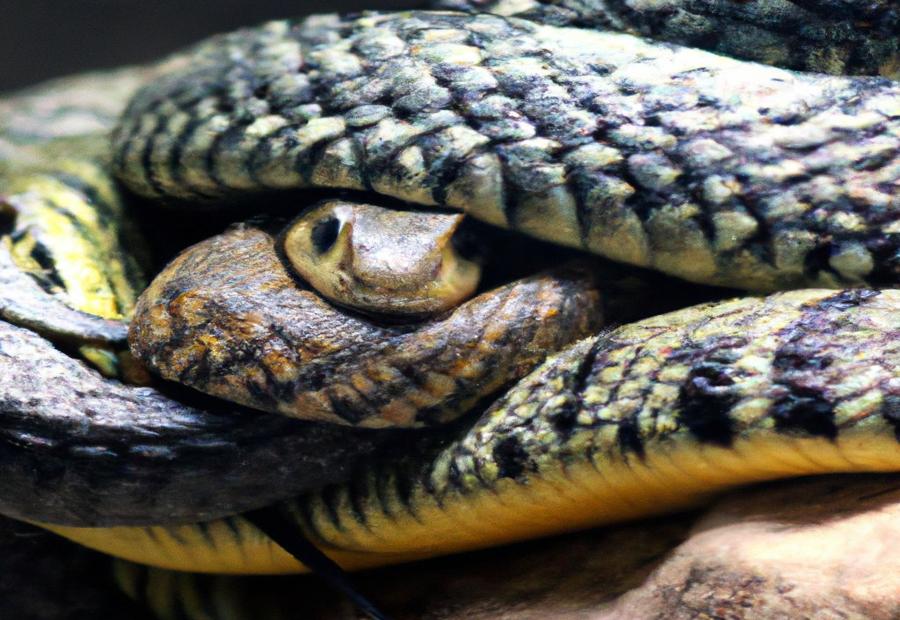
Photo Credits: Ruggedreptiles.Com by Timothy Thomas
Parental care is crucial for ensuring the survival of offspring in snakes, as it contributes to their well-being and development. Unlike many other reptiles, certain snake species exhibit behaviors to protect and nurture their young.
Female boas, for instance, practice internal incubation of their eggs, which greatly enhances the chances of survival for the developing embryos. Similarly, female pythons coil around their eggs to regulate temperature and ensure proper development.
Cobras and vipers also engage in brooding behaviors, with the female actively guarding her eggs against predators and environmental threats. This behavior cultivates the survival skills of the offspring.
Interestingly, in some cases, male snakes also play a role in parental care. Male anacondas, for example, protect the female and her eggs until hatching, which further boosts the survival prospects of the snake young.
However, it should be noted that not all snake species exhibit parental care. Some snakes simply lay their eggs and provide no further assistance or care, relying solely on the natural environment for the survival of their offspring.
To promote the survival of snake offspring, it is crucial to protect their habitats and refrain from disturbing nesting areas. Educating the public about the importance and role of snakes in ecosystems can greatly foster appreciation and support for conservation efforts.
The Evolution of Snake Mating Habits
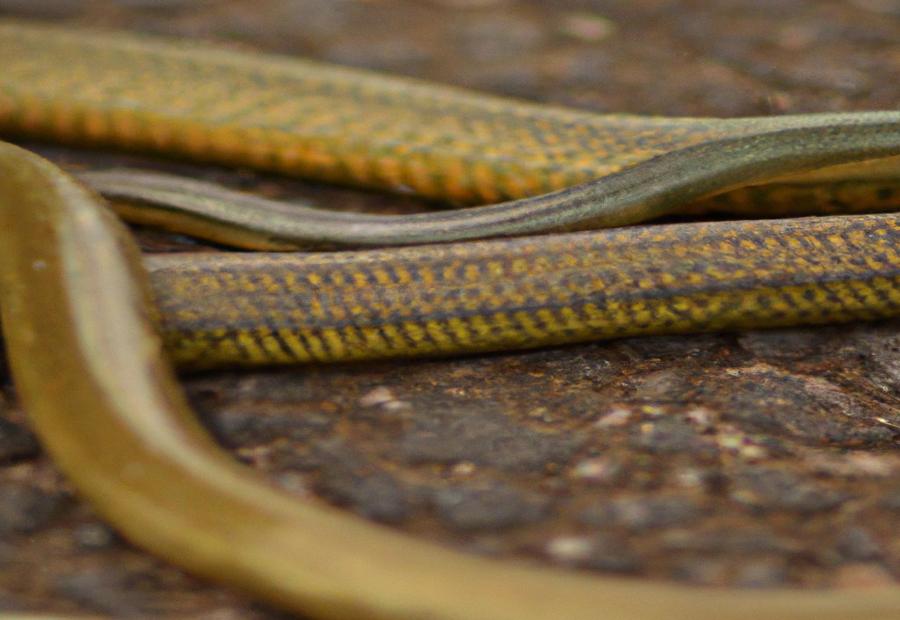
Photo Credits: Ruggedreptiles.Com by Eugene Robinson
The evolution of snake mating habits, such as courtship displays and copulation, has resulted in fascinating changes in these reptiles. Natural selection has played a significant role in the development of unique behaviors that ensure successful reproduction.
Male snakes employ intricate dances, rhythmic movements, or pheromones to attract female mates in courtship displays. Once a male snake has successfully courted a female, they engage in copulation. Snake mating can be complex, with males employing different techniques. Some species exhibit prolonged copulation, while others have evolved specialized reproductive organs.
Mating patterns vary among snake species. Some snakes are promiscuous, mating with multiple females, while others practice monogamy, forming long-term pair bonds. Due to the possibility of multiple males mating with the same female, sperm competition becomes important. Male snakes have developed adaptations to increase their chances of fertilization, such as producing more sperm or sperm with higher motility.
Additionally, sexual dimorphism is observed in many snake species, where males and females have noticeable differences in size or appearance. This disparity is a result of competition for mates, with males evolving attractive traits.
The evolution of snake mating habits is an ongoing process driven by reproductive success and survival. Understanding these adaptations provides valuable insights into the captivating world of snake reproduction.
Some Facts About Revealing the Intriguing Mating Habits of Snakes:
- ✅ Some snake species can reproduce without having sex, a process called parthenogenesis. (Source: Our Team)
- ✅ Snakes mate in different ways based on their location and species. (Source: Our Team)
- ✅ Male snakes have two penises, while females can store and select sperm. (Source: Our Team)
- ✅ Approximately 70% of snake species lay eggs, while the remaining 30% give live birth. (Source: Our Team)
- ✅ Snakes gather in mating balls, where multiple male snakes vie for a single female. (Source: National Geographic)
Frequently Asked Questions
1. What are some unique mating rituals of snakes?
Snakes have fascinating mating rituals, such as forming “mating balls” during springtime and engaging in one-on-one encounters. Some species can even reproduce through parthenogenesis, a process known as “virgin birth,” without mating with a male.
2. How do snakes reproduce and what are their reproductive organs like?
Snakes practice internal fertilization and have internal reproductive organs. Male snakes have dual penises called hemipenes, which they use during mating. Female snakes have a cloaca, which is the common opening for waste elimination and mating.
3. What are the different ways in which snakes mate based on their location?
Mating rituals of snakes vary based on location and species. Snakes in colder locations mate in early summer and late spring, while those in tropical areas mate year-round. Mating depends on the availability of food and appropriate temperatures for offspring.
4. How do male snakes mate with females?
Male snakes travel long distances during mating season to find a receptive female. They may engage in non-lethal combat, such as arm wrestling matches, and the winning male aligns his body with the female’s. The male inserts one of his hemipenes into the female’s cloaca, a process that can take hours depending on the species.
5. What happens after mating and how do baby snakes come into existence?
After mating and fertilization, the male and female snakes separate. The female may lay eggs immediately or keep them in her body for a while, depending on the species. Once the eggs are laid, the female places them in a nest for security. In the right environment with appropriate temperatures, the eggs will hatch, and baby snakes will emerge. The newborn snakes search for areas to live and eventually start looking for food.
6. Can you share an interesting location where snakes gather for mating?
Rural Manitoba, Canada, is home to the Narcisse Snake Dens, which host the largest gathering of snakes in the world. Each spring, red-sided garter snakes congregate inside limestone caves to form mating balls, where up to a hundred male snakes vie for a single female. This unique location provides the geological features and suitable habitat for such a large concentration of snakes.

